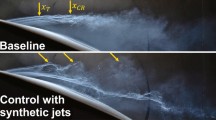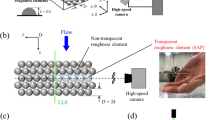Abstract
The challenge of turbulent kinetic energy dissipation rate estimation, in general, is associated with errors embedded in measured velocity vectors and spatial resolution of appropriate optical method. Different optical methods together with different filtering procedures may yield completely different estimations. To evaluate the sources for such discrepancies, key parameters and factors which directly affect the accuracy of the dissipation rate estimation are briefly discussed. A joint effect of random error, velocity vector spacing, IW size and IW overlap on the dissipation rate estimation is theoretically and experimentally shown. In the present study, we demonstrate that high-speed planar particle image velocimetry (PIV) enables accurate estimation of the dissipation rate if high spatiotemporal resolution and appropriate local temporal filtering procedure are utilized. We consider a synthetic linear shear flow and a turbulent boundary layer flow using an assumption of locally axisymmetric turbulence when estimating the dissipation rate. The calculated dissipation rate profiles are compared with measurements by the state-of-the-art optical methods such as planar smoke image velocimetry (SIV), Stereo PIV, Tomo PIV, Tomo PTV–VIC+, and DNS results. The advantages of the implemented technique compared to others and the temporal filtering procedure are discussed.
Graphical abstract














Similar content being viewed by others
References
Discetti S, Astarita T (2012) Fast 3D PIV with direct sparse cross-correlations. Exp Fluids 53:1437–1451. https://doi.org/10.1007/s00348-012-1370-9
Djenidi L, Antonia RA (2012) A spectral chart method for estimating the mean turbulent kinetic energy dissipation rate. Exp Fluids 53:1005–1013. https://doi.org/10.1007/s00348-012-1337-x
Elsinga GE, Scarano F, Wieneke B, van Oudheusden BW (2006) Tomographic particle image velocimetry. Exp Fluids 41:933–947. https://doi.org/10.1007/s00348-006-0212-z
Finnicum DS, Hanratty TJ (1988) Effect of favorable pressure gradients on turbulent boundary layers. AIChE J 34:529–540. https://doi.org/10.1002/aic.690340402
Foucaut JM, Stanislas M (2002) Some considerations on the accuracy and frequency response of some derivative filters applied to particle image velocimetry vector fields. Meas Sci Technol 13:1058–1071. https://doi.org/10.1088/0957-0233/13/7/313
Foucaut JM, Carlier J, Stanislas M (2004) PIV optimization for the study of turbulent flow using spectral analysis. Meas Sci Technol 15:1046–1058. https://doi.org/10.1088/0957-0233/15/6/003
Foucaut J-M, Cuvier C, Stanislas M, George WK (2016) Quantification of the full dissipation tensor from an L-shaped SPIV experiment in the near wall region. Springer, Cham, pp 429–439
Fouras A, Soria J (1998) Accuracy of out-of-plane vorticity measurements derived from in-plane velocity field data. Exp Fluids 25:409–430. https://doi.org/10.1007/s003480050248
Frigo M, Johnson SG (2005) The design and implementation of FFTW3. Proc IEEE 93:216–231. https://doi.org/10.1109/JPROC.2004.840301
George WK, Hussein HJ (1991) Locally axisymmetric turbulence. J Fluid Mech 233:1. https://doi.org/10.1017/S0022112091000368
Hearst RJ, Buxton ORH, Ganapathisubramani B, Lavoie P (2012) Experimental estimation of fluctuating velocity and scalar gradients in turbulence. Exp Fluids 53:925–942. https://doi.org/10.1007/s00348-012-1318-0
Huang HT, Fiedler HE, Wang JJ (1993a) Limitation and improvement of PIV. Part I: limitation of conventional techniques due to deformation of particle image patterns. Exp Fluids 15:168–174. https://doi.org/10.1007/BF00189883
Huang HT, Fiedler HE, Wang JJ (1993b) Limitation and improvement of PIV. Part II: particle image distortion, a novel technique. Exp Fluids 15:263–273. https://doi.org/10.1007/BF00223404
Kim BJ, Sung HJ (2006) A further assessment of interpolation schemes for window deformation in PIV. Exp Fluids 41:499–511. https://doi.org/10.1007/s00348-006-0177-y
Lavoie P, Avallone G, De Gregorio F et al (2007) Spatial resolution of PIV for the measurement of turbulence. Exp Fluids 43:39–51. https://doi.org/10.1007/s00348-007-0319-x
McKenna SP, McGillis WR (2002) Performance of digital image velocimetry processing techniques. Exp Fluids 32:106–115. https://doi.org/10.1007/s003480200011
Mikheev NI, Goltsman AE, Saushin II, Dushina OA (2017) Estimation of turbulent energy dissipation in the boundary layer using smoke image velocimetry. Exp Fluids 58:97. https://doi.org/10.1007/s00348-017-2379-x
Nogueira J, Lecuona A, Rodríguez PA (2001) Identification of a new source of peak locking, analysis and its removal in conventional and super-resolution PIV techniques. Exp Fluids 30:309–316. https://doi.org/10.1007/s003480000179
Oxlade AR, Valente PC, Ganapathisubramani B, Morrison JF (2012) Denoising of time-resolved PIV for accurate measurement of turbulence spectra and reduced error in derivatives. Exp Fluids 53:1561–1575. https://doi.org/10.1007/s00348-012-1375-4
Piirto M, Saarenrinne P, Eloranta H, Karvinen R (2003) Measuring turbulence energy with PIV in a backward-facing step flow. Exp Fluids 35:219–236. https://doi.org/10.1007/s00348-003-0607-z
Pope SB (2000) Turbulent flows. Cambridge University Press, Cambridge
Raffel M, Willert CE, Wereley ST, Kompenhans J (2007) Particle image velocimetry: a practical guide. Springer, Berlin
Saarenrinne P, Piirto M (2000) Turbulent kinetic energy dissipation rate estimation from PIV velocity vector fields. Exp Fluids 29:S300–S307. https://doi.org/10.1007/s003480070032
Scarano F, Riethmuller ML (2000) Advances in iterative multigrid PIV image processing. Exp Fluids 29:S051–S060. https://doi.org/10.1007/s003480070007
Scharnowski S, Kähler CJ (2016) Estimation and optimization of loss-of-pair uncertainties based on PIV correlation functions. Exp Fluids 57:1–11. https://doi.org/10.1007/s00348-015-2108-2
Schlatter P, Orlu R (2010) Assessment of direct numerical simulation data of turbulent boundary layers. J Fluid Mech 659:116–126. https://doi.org/10.1017/S0022112010003113
Schlatter P, Örlü R, Li Q et al (2009) Turbulent boundary layers up to Re θ = 2500 studied through simulation and experiment. Phys Fluids. https://doi.org/10.1063/1.3139294
Schneiders JFG, Scarano F, Elsinga GE (2017) Resolving vorticity and dissipation in a turbulent boundary layer by tomographic PTV and VIC+. Exp Fluids 58:27. https://doi.org/10.1007/s00348-017-2318-x
Shah MK, Agelinchaab M, Tachie MF (2008) Influence of PIV interrogation area on turbulent statistics up to 4th order moments in smooth and rough wall turbulent flows. Exp Therm Fluid Sci 32:725–747. https://doi.org/10.1016/j.expthermflusci.2007.09.004
Sharp KV, Adrian RJ (2001) PIV study of small-scale flow structure around a Rushton turbine. AIChE J 47:766–778. https://doi.org/10.1002/aic.690470403
Sheng J, Meng H, Fox RO (2000) A large eddy PIV method for turbulence dissipation rate estimation. Chem Eng Sci 55:4423–4434. https://doi.org/10.1016/S0009-2509(00)00039-7
Tanaka T, Eaton JK (2007) A correction method for measuring turbulence kinetic energy dissipation rate by PIV. Exp Fluids 42:893–902. https://doi.org/10.1007/s00348-007-0298-y
Tokgoz S, Elsinga GE, Delfos R, Westerweel J (2012) Spatial resolution and dissipation rate estimation in Taylor–Couette flow for tomographic PIV. Exp Fluids 53:561–583. https://doi.org/10.1007/s00348-012-1311-7
Wereley ST, Meinhart CD (2001) Second-order accurate particle image velocimetry. Exp Fluids 31:258–268. https://doi.org/10.1007/s003480100281
Westerweel J, Scarano F (2005) Universal outlier detection for PIV data. Exp Fluids 39:1096–1100. https://doi.org/10.1007/s00348-005-0016-6
Westerweel J, Draad AA, van der Hoeven JGT, van Oord J (1996) Measurement of fully-developed turbulent pipe flow with digital particle image velocimetry. Exp Fluids 20:165–177. https://doi.org/10.1007/BF00190272
Westerweel J, Elsinga GE, Adrian RJ (2013) Particle image velocimetry for complex and turbulent flows. Annu Rev Fluid Mech 45:409–436. https://doi.org/10.1146/annurev-fluid-120710-101204
Willert CE (2015) High-speed particle image velocimetry for the efficient measurement of turbulence statistics. Exp Fluids. https://doi.org/10.1007/s00348-014-1892-4
Wu X, Moin P (2009) Direct numerical simulation of turbulence in a nominally zero-pressure-gradient flat-plate boundary layer. J Fluid Mech 630:5. https://doi.org/10.1017/S0022112009006624
Acknowledgements
The authors would like to thank the anonymous reviewers for their insightful comments. Experimental studies were performed within the framework of the state assignment of FRC Kazan Scientific Center of RAS No. AAAA-A18-118032690290-1.
Author information
Authors and Affiliations
Corresponding author
Additional information
Publisher’s Note
Springer Nature remains neutral with regard to jurisdictional claims in published maps and institutional affiliations.
Rights and permissions
About this article
Cite this article
Zaripov, D., Li, R. & Dushin, N. Dissipation rate estimation in the turbulent boundary layer using high-speed planar particle image velocimetry. Exp Fluids 60, 18 (2019). https://doi.org/10.1007/s00348-018-2663-4
Received:
Revised:
Accepted:
Published:
DOI: https://doi.org/10.1007/s00348-018-2663-4




